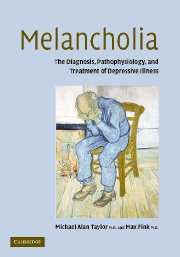Book contents
- Frontmatter
- Contents
- List of patient vignettes
- Preface
- Acknowledgments
- 1 Melancholia: a conceptual history
- 2 Melancholia defined
- 3 Defining melancholia by psychopathology
- 4 Defining melancholia: laboratory tests
- 5 Examination for melancholia
- 6 The differential diagnosis of melancholia
- 7 Suicide in melancholia
- 8 Electroconvulsive therapy for melancholia
- 9 Achieving effective ECT
- 10 The validity of the pharmacotherapy literature in melancholia
- 11 Basic pharmacotherapy for melancholic patients
- 12 Pharmacotherapy for melancholic patients in complicating circumstances
- 13 Proposed treatments for melancholia
- 14 The pathophysiology of melancholia
- 15 Future directions
- References
- Index
2 - Melancholia defined
Published online by Cambridge University Press: 14 August 2009
- Frontmatter
- Contents
- List of patient vignettes
- Preface
- Acknowledgments
- 1 Melancholia: a conceptual history
- 2 Melancholia defined
- 3 Defining melancholia by psychopathology
- 4 Defining melancholia: laboratory tests
- 5 Examination for melancholia
- 6 The differential diagnosis of melancholia
- 7 Suicide in melancholia
- 8 Electroconvulsive therapy for melancholia
- 9 Achieving effective ECT
- 10 The validity of the pharmacotherapy literature in melancholia
- 11 Basic pharmacotherapy for melancholic patients
- 12 Pharmacotherapy for melancholic patients in complicating circumstances
- 13 Proposed treatments for melancholia
- 14 The pathophysiology of melancholia
- 15 Future directions
- References
- Index
Summary
Melancholy
(n.) - c.1303, “condition characterized by sullenness, gloom, irritability,” from O.Fr. melancholie, from L. L. melancholia, from Gk. melankholia “sadness,” lit. “black bile,” from melas (gen. melanos) “black” (see melanin) + khole “bile.”
Medieval physiology attributed depression to excess of “black bile,” a secretion of the spleen and one of the body's four “humors.”
Adj.sense of “sullen, gloomy” is from 1526; sense of “deplorable” (of a fact or state of things) is from 1710.
The precision of medical diagnostic terms is essential to establish the reliability and validity of proposed disease states. While the term “depression” is widely used in society, its meaning varies with the user, an attitude best expressed by Alice in Wonderland's Humpty-Dumpty, “When I use a word, it means just what I choose it to mean – neither more nor less.” In psychology, depression represents a decrease in psychomotor activity or intellectual agility. Within neurophysiology, depression refers to a decrease in the brain's functioning, measured in electrical activity or cerebral blood flow. For the pharmacologist, depression means the decrease in body functions induced by sedatives, soporifics, and anesthetics. In clinical practice, depression describes a normal human emotion, a pathologic state if it is retained too long or too deeply, or a psychopathologic syndrome that may be mild or severe. A clinical depressive episode may be defined by its associated adverse life events or it may strike a subject without cause.
- Type
- Chapter
- Information
- MelancholiaThe Diagnosis, Pathophysiology and Treatment of Depressive Illness, pp. 15 - 44Publisher: Cambridge University PressPrint publication year: 2006
- 1
- Cited by

